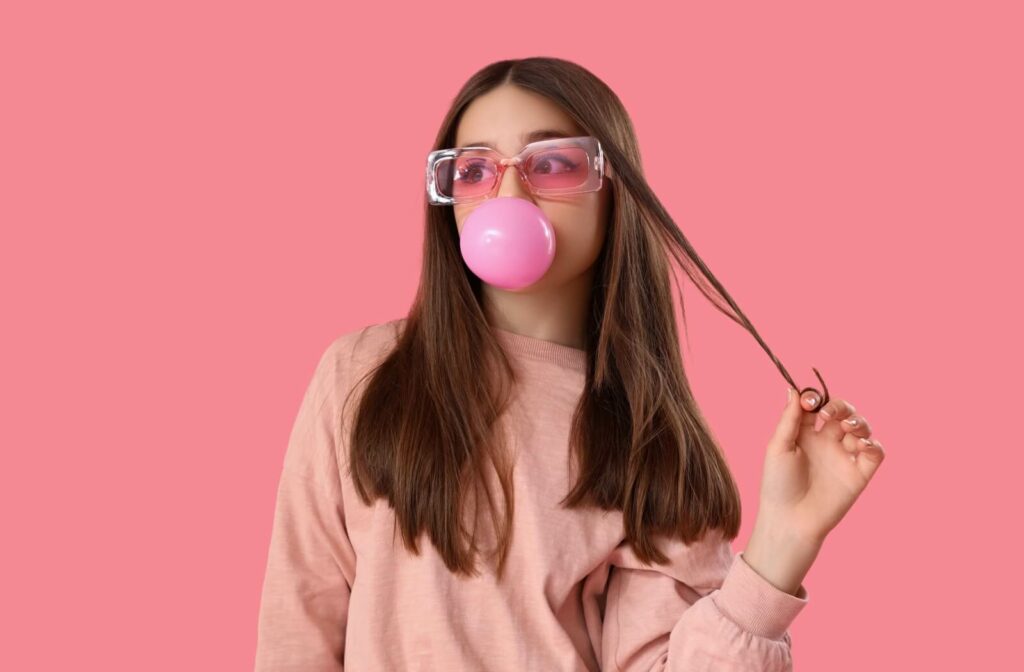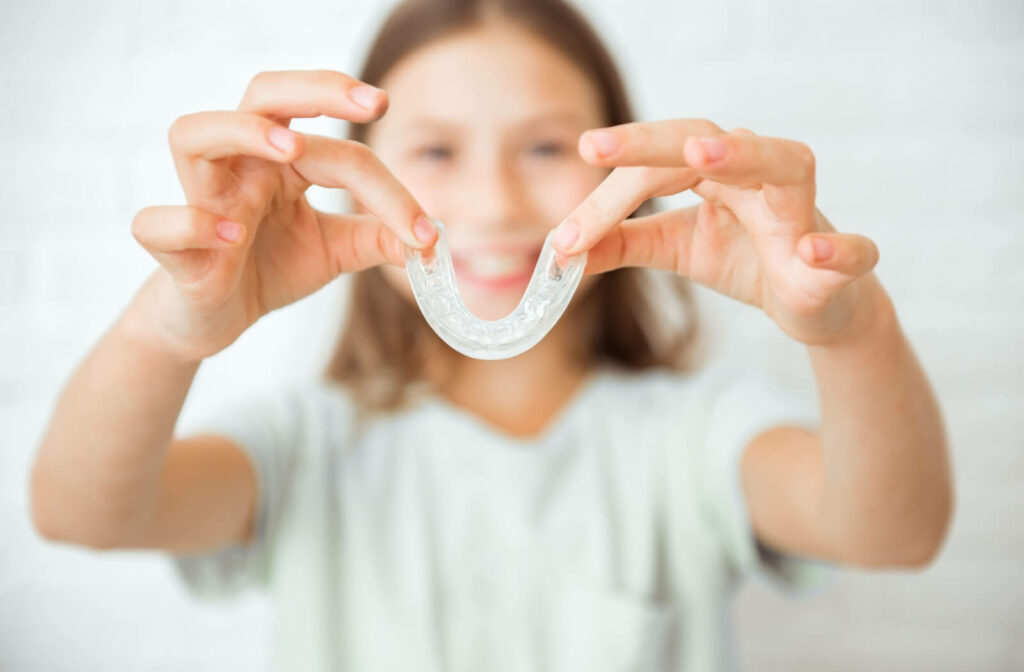Invisalign offers a discreet and comfortable alternative to traditional metal braces to correct problems like gaps in your smile, overcrowded teeth, cross bites, overbites, and underbites. However, since Invisalign treatment can take anywhere from six months to a year (or longer), people often have questions about Invisalign.
One of the most common questions about Invisalign is whether you can chew gum with it. The answer is no, because chewing gum can get stuck to the aligner, making removal difficult. Let’s walk through everything you need to know to ensure your child’s Invisalign treatment is as smooth and effective as possible.
What is Invisalign?
Invisalign is a modern orthodontic treatment that uses clear, removable aligners to straighten teeth. Unlike traditional braces, Invisalign aligners are nearly invisible, making them popular for teens and adults. They are custom-made to fit snugly over your teeth and gradually shift them into the desired position. Every one to two weeks, you’ll switch to a new set of aligners that continue to shift your teeth.
Invisalign aligners are made from a proprietary, multilayer SmartTrack material that is both durable and flexible. This ensures that the aligners remain comfortable to wear while applying gentle, constant pressure to teeth.
Additionally, Invisalign offers the advantage of being removable, allowing you to eat, drink, brush, and floss without the restrictions typically associated with traditional braces.
Invisalign Do’s
Follow these essential practices to get the best results from your Invisalign treatment, to help you maintain your aligners, and to ensure your treatment progresses smoothly.
- Wear your aligners consistently. One of the most critical aspects of successful Invisalign treatment is wearing your aligners for the recommended 20-22 hours per day. Consistency ensures that your teeth are continually guided to the correct position. Only remove your aligners when eating, drinking (other than water), brushing, or flossing.
- Regularly clean your aligners. Maintaining good oral hygiene is essential when using Invisalign. Clean your aligners daily using a soft toothbrush and lukewarm water. Avoid using toothpaste, as it can be abrasive and scratch the aligners. Special Invisalign cleaning crystals or a gentle, clear anti-bacterial soap can also be used for a thorough clean.
- Store Your Aligners Properly. When you remove your aligners, always store them in their designated case. Leaving them out in the open increases the risk of losing or exposing them to bacteria. The case also protects them from accidental damage.
- Follow your orthodontist’s instructions. Your orthodontist will provide specific instructions tailored to your treatment plan. This includes when to switch to a new set of aligners and any additional steps you might need to follow.
Regular check-ups ensure your treatment is on track, so attend your appointments.
Invisalign Don’ts
While the do’s are essential, there are also critical don’ts you must be aware of to avoid compromising your treatment.
- Don’t eat or drink with aligners in. Eating or drinking anything other than water while wearing your aligners can cause staining, distortion, or damage. Food particles can also get trapped between your aligners and teeth, leading to plaque buildup and potential cavities. Always remove your aligners before meals and snacks.
- Don’t use harsh cleansers. Cleaning your aligners with harsh chemicals or hot water can damage them. Hot water can warp the plastic, rendering it ineffective. Stick to lukewarm water and mild cleaning solutions specifically designed for Invisalign or clear aligners.

Why does chewing gum affect Invisalign?
Chewing gum can significantly impact the effectiveness and condition of your Invisalign aligners. The sticky texture of gum can easily adhere to the aligners, making it challenging to remove and clean. This residue can accumulate over time, leading to unsightly stains and a breeding ground for bacteria.
Additionally, chewing gum exerts pressure on the aligners, potentially causing them to warp or crack. Sugar-free gum, which may seem safer, can still cause these issues. The misalignment of aligners due to chewing gum can hinder the proper movement of your teeth, prolonging treatment time.
Chewing gum can also break the aligner’s seal, which is crucial for applying force to your teeth. A broken seal means reduced effectiveness and slower progress in your treatment plan.
Is there anything you shouldn’t eat with Invisalign?
In addition to chewing gum, many foods and drinks should be avoided or consumed with caution during your Invisalign treatment.
- Sticky and chewy foods like caramel and candies can cling to your teeth and aligners, making them hard to clean. These foods can also pull on the aligners, potentially causing them to become dislodged or damaged.
- Hard foods such as nuts, hard candies, and ice can crack or damage your aligners.
- Staining foods and drinks like coffee, tea, red wine, and berries can stain your aligners. Consuming these with your aligners in place can result in discoloration that is difficult to clean.
Pros & Cons of Invisalign
All these do’s and don’ts can make Invisalign sound daunting, especially for a child or teen. Understanding the advantages and disadvantages of Invisalign can help you make an informed decision about your child’s orthodontic treatment.
Pros
- Aesthetics. Invisalign aligners are virtually invisible, making them a discrete option for teeth straightening.
- Removability. The ability to remove Invisalign aligners allows for more flexibility in daily activities. You can eat and drink without restrictions and easily maintain better oral hygiene by brushing and flossing.
- Comfort. Invisalign aligners are made from smooth, comfortable plastic, reducing the likelihood of irritation often experienced with traditional braces.
Cons
- Discipline Required. Aligners must be worn for 20-22 hours daily, which can be challenging for some users.
- Cost. Invisalign can be more expensive than traditional braces. However, many find the benefits outweigh the cost, especially with flexible payment options and insurance coverage.
- Maintenance. Keeping aligners clean and consistently wearing them requires diligence to avoid suboptimal results and prolonged treatment time.
Bloom Orthodontics understands that traditional braces are not ideal for anyone. We work with our patients to create customized Invisalign treatment plans. Contact us today to see how we can improve your child’s smile.



